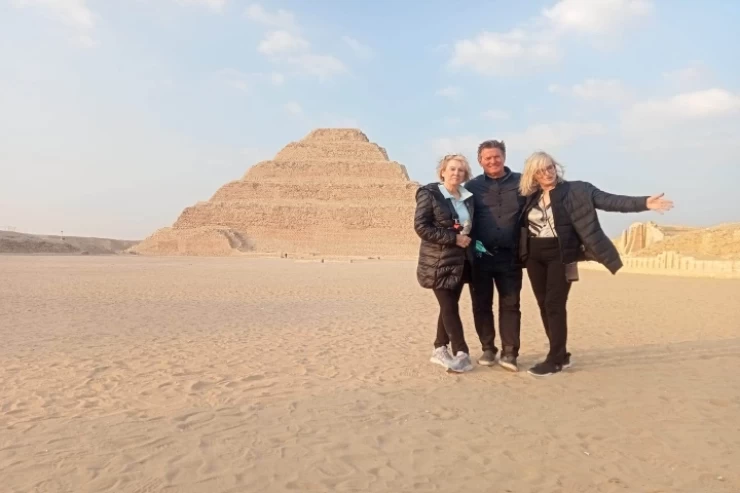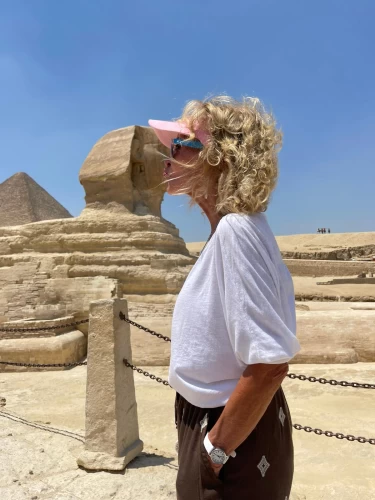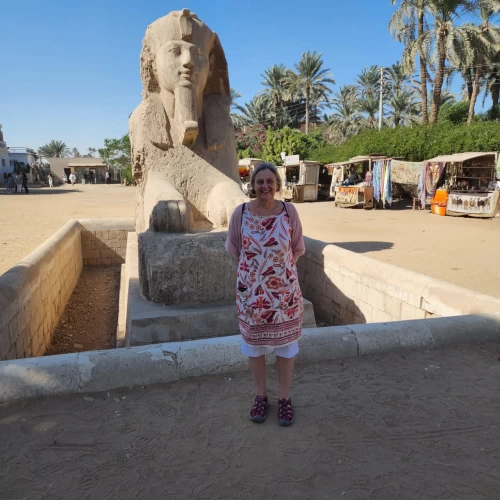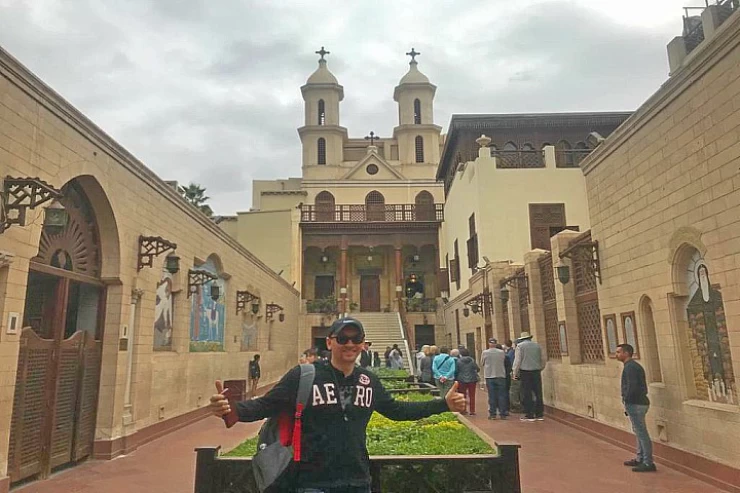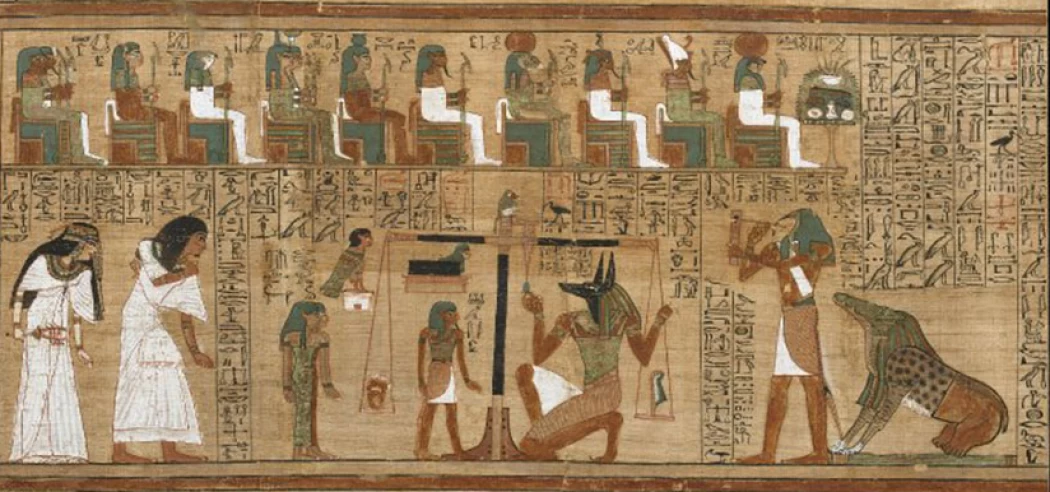
Religion in Egypt
Religion in Egypt: A Tapestry of Beliefs Shaping Millennia of History
If Egypt has often been referenced by historians as ‘the Cradle of Civilization’, it has probably one of the most complicated religious aspects in entire human history. The fertile banks of the Nile did host agriculture, but they also produced a vast culture, where religion permeated every single aspect of everyday life, politics, and social order. From the earliest days of ancient Egyptian civilization up to this day, despite being primarily a desert dry land, Egypt has been a melting pot of different religions, starting from polygamy to finally embracing monotheism.
In this piece, Section II, How We Were: Reflections on Egyptian History, From Ancient Polytheism to Christianity & Islam, will be reviewed and analyzed, as well as the role of religion in the lives of the Egyptian population.
1. Ancient Egyptian Religion: Polytheism and the Pantheon of Gods
As a society, it can be said that religion was the foundation of ancient Egypt. The ancient Egyptians worshiped as they knew that everything from the annual flooding of the Nile to the cycle of life and death was not only natural but controlled by some divine power. This was a belief characterized by a multiplicity of deities, all of whom were in charge of a specific facet of existence and/or nature.
The Major Gods and Goddesses
Ra (or Re): Revered as the God of the Sun, Ra has been depicted as the most potent deity in ancient Egyptian religion. It was believed that Ra inhabited the sky during the day, providing light to the earth, and resided in the underworld at night. He would oftentimes be portrayed with a falcon’s head and wear a sun disk on top of his head.
Osiris: Osiris was an Egyptian death and resurrection god and held a significant place in Egyptian mythology in representing the concept of life as a cycle of birth, death, and resurrection. The Osiris myth and his resurrection, in the capable hands of Isis, his wife, became the pillars of the Egyptian afterlife experience.
The goddess was immensely popular and powerful. She was a protector of motherhood, magic, and fertility. Her protective aspect and the ability to bring Osiris back to life made her worshiped.
Horus, the god of the sky and of the king, is often shown as a hawk. He was also known because of his rivalry with the chaos god Set for dominion over the land of Egypt, which represents the struggle of order and chaos.
Anubis is the Egyptian god associated with funerary rites and the protection of the dead. He had the important task of supervising the ceremony of the heart's weighing, which assessed a person’s spirit in the next world.
The gods were not distant or abstract figures; they were present in every facet of life. Egyptians built temples across the country, conducted elaborate rituals, and offered daily prayers and sacrifices to ensure the favor of the gods and maintain ma’at—harmony and order.
Temples and Priests: The Bridge Between the Divine and the Mortal
Worship wasn’t the only reason for building temples; these structures were believed to be the earthly homes of the gods. The pharaohs had enormous temples like Karnak and Luxor built to worship and carry out rituals for the gods as well as to showcase the power of their rule over the land. No one was permitted to enter the temple’s most sacred, innermost areas except for the priests, who were thought to be the only ones capable of interacting with the gods.
Priests offered meals, incense, and prayers to the gods on a daily basis, performing their duties towards ensuring the gods’ continuous provision of security over the land of Egypt. These clergymen were very powerful and at times even had political authority as they helped the pharaohs in religious affairs.
2. The Afterlife: A Journey of Eternal Importance
For the Ancients, death was not a permanent end; there would be life after death. This notion fueled the people’s efforts to focus on death and think about how they would prepare in the appropriate way for their journey to the underworld, which in their minds was not an easy place to reach but one that guaranteed everlasting bliss as long as the challenges were overcome.
Mummification and the Preservation of the Body
Mummification was pivotal in shaping the Egyptian view of what happens when one dies. The body was to be maintained so that the ‘ka’ (or soul) would remember and go back to its residence after death. Mummification came to be practiced with a set of procedures that included arts of organ procurement, chemical treatment, and linen envelopment of the entire body.
A process of putting up preparatory arrangements for one’s afterlife would also include making tombs, which would have items that the dead person would require, such as food, clothes, and upright ‘ushabti’ figures meant to depict servants. The magnificence that royal burial places such as the Giza pyramids and those in the Valley of the Kings display indicates the extreme measures taken to ensure adequate rest and healthcare for the leaders when they die.
The mummification custom was bound to the Egyptian people's love of the afterlife. Bodies had to be maintained in a way that allowed the spirit, or 'ka', to identify it and be able to go back in after death. Mummification came to be seen with specific practices, which included the arts of organ downsizing, substance drying, and body plastering with bandages.
Another aspect of preparing for eternity was that of constructing tombs containing the essentials for the deceased, such as an abundance of food and clothes and miniature statues of servants known as ushabtis. Such an adulation can be seen from the wonderful construction of royal burial sites such as those surrounding the Great Pyramids of Giza and along the Valley of the Kings, where endless hope lies for the reasonable resting of the leaders within the period of their deaths.
The Weighing of the Heart Ceremony
The “weighing of the heart” ritual is one of the key convictions regarding the hereafter. In Egyptian cosmology, when a deceased individual was brought to the land of the dead, the god Anubis was tasked with weighing the heart against the feather of Ma’at, the deity representing truth and justice. Where the scales tipped in favor of the feather, the individual was considered fit to take his place among the dead in the other world. If the heart tipped the scale against the feather, then due to some impertinent act or lie, that heart would be consumed by the ferocious goddess Amit and the essence would no longer exist.
3. The Introduction of Monotheism: The Amarna Period
Throughout the reign of Pharaoh Akhenaten, also known as Amenhotep IV, which was between the years 1353 and 1336 BCE, many changes were witnessed, especially in Egyptian religious practices. Akhenaten believed there was only one God to worship, and that was Aten, the sun disk, and he promoted the worship of Aten only. He constructed a new city called Akhetaten (Amarna, modern) and concentrated on the worship of this one god, excluding completely the rest of the traditional deities in the Egyptian pantheon.
The extent of how long this extreme change in religious practices lasted is very minimal. After the death of Akhenaten, the former worship of many gods was reinstated by the administrations that followed him, particularly through King Tutankhamun, and the cult of Aten was, for the most part, expunged from history. Still, the issue of Akhenaten's obsessive tendencies concerning religion remains a curious page in the story of religions in ancient Egypt. It demonstrates how potential changes in religion can be such a threat even when a rigid system is in place.
4. The Rise of Christianity in Egypt
It is known that the spread of Christianity took root at the point when the Romans conquered Egypt sometime in 30 B.C.E. Widespread settlements of Christians started in AD in several areas, especially Alexandria, where it became a hub for the establishment of education on Christian matters and also church orthodoxy. Therefore, the arrival of St. Mark in the city of Alexandria is regarded as a date for the founding of the Coptic Church, which is often considered one of the most ancient churches.
Nevertheless, the ideology that Christianity preached became accepted by a majority in the heaviest waves of persecution, which was more pronounced during the period of the Roman kings. However, in the 4 century A.D. era of Emperor Constantine's rule, Christianity became the most used religion, and it was embraced fully and officially in the entire empire.
While the Coptic Church remains under the Patriarchate of Alexandria, it has also been able to cultivate a few of its own local traditions, language (Coptic, a derivative of the Ancient Egyptian Language), and artistic style. Coptic Christianity has been, and remains, an essential part of the religious makeup of Egypt, with most Copts being Orthodox Christians, who form a large section of the population in modern Egypt.
5. Islam in Egypt: The Dawn of a New Era
In the 7th century, Egypt saw another seismic change in its religion—the coming of Islam. In 641 CE, Arab General Amr ibn Al-As invaded Egypt, and over a few centuries, Islam became the major religion in the country, causing the disappearance of local customs and even Christianity.
With the introduction of Islamic rule, the history of Egypt witnessed the height of cultural and intellectual activities, most especially during the Fatimid and Mamluk dynasties. In 969 CE, the Fatimids established a city that later came to be known as Cairo owing to its many mosques, which included Al Azhar, one of the oldest places of higher Islamic education that is still standing today and still functioning as a holy Islamic university.
Currently, Islam is still the largest religion in Egypt, with the majority of its population being Sunni Muslims. Despite this, however, Egypt still has a large number of Christians, primarily the Copts, who demonstrate the internally reconciled various ethnic groups throughout the history of Egyptian religions.
6. Modern Religious Life in Egypt
Religion remains a central part of the daily life of an average Egyptian citizen. The Muslim call to prayer, called “adhan,” can be heard from mosques five times a day, each alerting the Muslims to refrain from what they are doing and pray. Traditions such as Ramadan, Eid al-Fitr, and Eid al-Adha are celebrated with particular pomp and splendor, involving members of families and even relatives.
Holidays of the Christian calendar, for example, Christmas (January 7), and Easter (date varies), are also actively celebrated with church services as well as celebrations in the streets. Nonetheless, certain occasions have witnessed some degree of animosity between religious groups. Egypt’s rough and diffused history has made it possible for the country to be appreciated for its peaceful existence of different faiths and sects.
Conclusion
The history of religion in Egypt shows a drastic transition over thousands of years, spanning from the polytheism of ancient Egyptians to the birth of Christianity and the subsequent conversion of the entire country to Islam. There are elements from each of these periods that dominated Egyptian culture, society, and architecture, ranging from the great temples of Luxor and Karnak to the high minarets in Cairo.
The narrative of religion in Egypt is a celebration of the endurance of belief and the adaptability and flourishing of a people through great upheavals in their spiritual landscape. To this day, Egypt is still where the old and the new coexist in harmony, albeit clashing in practices and beliefs, where these practices are embraced by millions.
If Egypt has often been referenced by historians as ‘the Cradle of Civilization’, it has probably one of the most complicated religious aspects in entire human history. The fertile banks of the Nile did host agriculture, but they also produced a vast culture, where religion permeated every single aspect of everyday life, politics, and social order. From the earliest days of ancient Egyptian civilization up to this day, despite being primarily a desert dry land, Egypt has been a melting pot of different religions, starting from polygamy to finally embracing monotheism.
In this piece, Section II, How We Were: Reflections on Egyptian History, From Ancient Polytheism to Christianity & Islam, will be reviewed and analyzed, as well as the role of religion in the lives of the Egyptian population.
As a society, it can be said that religion was the foundation of ancient Egypt. The ancient Egyptians worshiped as they knew that everything from the annual flooding of the Nile to the cycle of life and death was not only natural but controlled by some divine power. This was a belief characterized by a multiplicity of deities, all of whom were in charge of a specific facet of existence and/or nature.
The Major Gods and Goddesses
Ra (or Re): Revered as the God of the Sun, Ra has been depicted as the most potent deity in ancient Egyptian religion. It was believed that Ra inhabited the sky during the day, providing light to the earth, and resided in the underworld at night. He would oftentimes be portrayed with a falcon’s head and wear a sun disk on top of his head.
Osiris: Osiris was an Egyptian death and resurrection god and held a significant place in Egyptian mythology in representing the concept of life as a cycle of birth, death, and resurrection. The Osiris myth and his resurrection, in the capable hands of Isis, his wife, became the pillars of the Egyptian afterlife experience.
The goddess was immensely popular and powerful. She was a protector of motherhood, magic, and fertility. Her protective aspect and the ability to bring Osiris back to life made her worshiped.
Horus, the god of the sky and of the king, is often shown as a hawk. He was also known because of his rivalry with the chaos god Set for dominion over the land of Egypt, which represents the struggle of order and chaos.
Anubis is the Egyptian god associated with funerary rites and the protection of the dead. He had the important task of supervising the ceremony of the heart's weighing, which assessed a person’s spirit in the next world.
The gods were not distant or abstract figures; they were present in every facet of life. Egyptians built temples across the country, conducted elaborate rituals, and offered daily prayers and sacrifices to ensure the favor of the gods and maintain ma’at—harmony and order.
Worship wasn’t the only reason for building temples; these structures were believed to be the earthly homes of the gods. The pharaohs had enormous temples like Karnak and Luxor built to worship and carry out rituals for the gods as well as to showcase the power of their rule over the land. No one was permitted to enter the temple’s most sacred, innermost areas except for the priests, who were thought to be the only ones capable of interacting with the gods.
Priests offered meals, incense, and prayers to the gods on a daily basis, performing their duties towards ensuring the gods’ continuous provision of security over the land of Egypt. These clergymen were very powerful and at times even had political authority as they helped the pharaohs in religious affairs.
For the Ancients, death was not a permanent end; there would be life after death. This notion fueled the people’s efforts to focus on death and think about how they would prepare in the appropriate way for their journey to the underworld, which in their minds was not an easy place to reach but one that guaranteed everlasting bliss as long as the challenges were overcome.
Mummification and the Preservation of the Body
Mummification was pivotal in shaping the Egyptian view of what happens when one dies. The body was to be maintained so that the ‘ka’ (or soul) would remember and go back to its residence after death. Mummification came to be practiced with a set of procedures that included arts of organ procurement, chemical treatment, and linen envelopment of the entire body.
A process of putting up preparatory arrangements for one’s afterlife would also include making tombs, which would have items that the dead person would require, such as food, clothes, and upright ‘ushabti’ figures meant to depict servants. The magnificence that royal burial places such as the Giza pyramids and those in the Valley of the Kings display indicates the extreme measures taken to ensure adequate rest and healthcare for the leaders when they die.
The mummification custom was bound to the Egyptian people's love of the afterlife. Bodies had to be maintained in a way that allowed the spirit, or 'ka', to identify it and be able to go back in after death. Mummification came to be seen with specific practices, which included the arts of organ downsizing, substance drying, and body plastering with bandages.
Another aspect of preparing for eternity was that of constructing tombs containing the essentials for the deceased, such as an abundance of food and clothes and miniature statues of servants known as ushabtis. Such an adulation can be seen from the wonderful construction of royal burial sites such as those surrounding the Great Pyramids of Giza and along the Valley of the Kings, where endless hope lies for the reasonable resting of the leaders within the period of their deaths.
The “weighing of the heart” ritual is one of the key convictions regarding the hereafter. In Egyptian cosmology, when a deceased individual was brought to the land of the dead, the god Anubis was tasked with weighing the heart against the feather of Ma’at, the deity representing truth and justice. Where the scales tipped in favor of the feather, the individual was considered fit to take his place among the dead in the other world. If the heart tipped the scale against the feather, then due to some impertinent act or lie, that heart would be consumed by the ferocious goddess Amit and the essence would no longer exist.
3. The Introduction of Monotheism: The Amarna Period
Throughout the reign of Pharaoh Akhenaten, also known as Amenhotep IV, which was between the years 1353 and 1336 BCE, many changes were witnessed, especially in Egyptian religious practices. Akhenaten believed there was only one God to worship, and that was Aten, the sun disk, and he promoted the worship of Aten only. He constructed a new city called Akhetaten (Amarna, modern) and concentrated on the worship of this one god, excluding completely the rest of the traditional deities in the Egyptian pantheon.
The extent of how long this extreme change in religious practices lasted is very minimal. After the death of Akhenaten, the former worship of many gods was reinstated by the administrations that followed him, particularly through King Tutankhamun, and the cult of Aten was, for the most part, expunged from history. Still, the issue of Akhenaten's obsessive tendencies concerning religion remains a curious page in the story of religions in ancient Egypt. It demonstrates how potential changes in religion can be such a threat even when a rigid system is in place.







